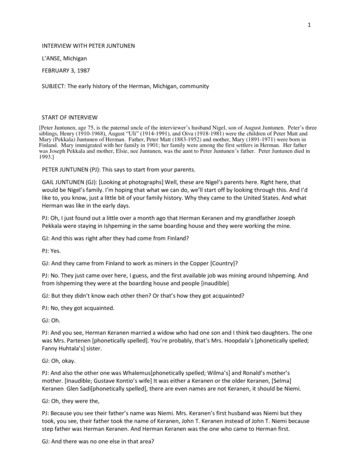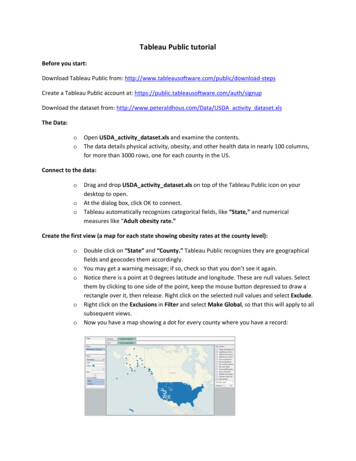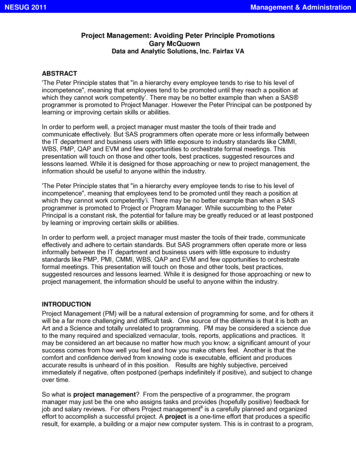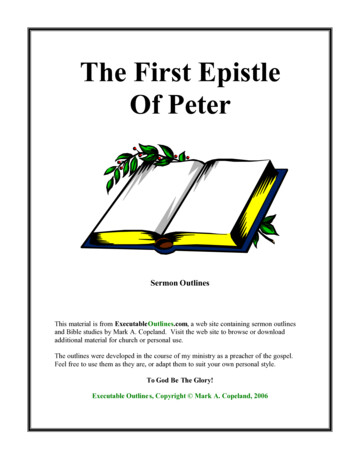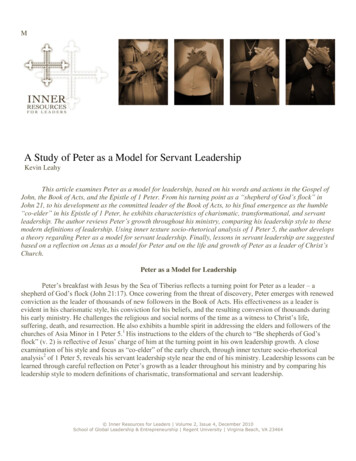
Transcription
MA Study of Peter as a Model for Servant LeadershipKevin LeahyThis article examines Peter as a model for leadership, based on his words and actions in the Gospel ofJohn, the Book of Acts, and the Epistle of 1 Peter. From his turning point as a “shepherd of God’s flock” inJohn 21, to his development as the committed leader of the Book of Acts, to his final emergence as the humble“co-elder” in his Epistle of 1 Peter, he exhibits characteristics of charismatic, transformational, and servantleadership. The author reviews Peter’s growth throughout his ministry, comparing his leadership style to thesemodern definitions of leadership. Using inner texture socio-rhetorical analysis of 1 Peter 5, the author developsa theory regarding Peter as a model for servant leadership. Finally, lessons in servant leadership are suggestedbased on a reflection on Jesus as a model for Peter and on the life and growth of Peter as a leader of Christ’sChurch.Peter as a Model for LeadershipPeter’s breakfast with Jesus by the Sea of Tiberius reflects a turning point for Peter as a leader – ashepherd of God’s flock (John 21:17). Once cowering from the threat of discovery, Peter emerges with renewedconviction as the leader of thousands of new followers in the Book of Acts. His effectiveness as a leader isevident in his charismatic style, his conviction for his beliefs, and the resulting conversion of thousands duringhis early ministry. He challenges the religious and social norms of the time as a witness to Christ’s life,suffering, death, and resurrection. He also exhibits a humble spirit in addressing the elders and followers of thechurches of Asia Minor in 1 Peter 5.1 His instructions to the elders of the church to “Be shepherds of God’sflock” (v. 2) is reflective of Jesus’ charge of him at the turning point in his own leadership growth. A closeexamination of his style and focus as “co-elder” of the early church, through inner texture socio-rhetoricalanalysis2 of 1 Peter 5, reveals his servant leadership style near the end of his ministry. Leadership lessons can belearned through careful reflection on Peter’s growth as a leader throughout his ministry and by comparing hisleadership style to modern definitions of charismatic, transformational and servant leadership. Inner Resources for Leaders Volume 2, Issue 4, December 2010School of Global Leadership & Entrepreneurship Regent University Virginia Beach, VA 23464
Leahy – Peter Servant Leader - 2“Feed my Sheep” - A Transformed LeaderThroughout the Gospels, Peter’s interactions with Jesus and the disciples reflect a leader who isimpulsive, ambitious, self-assertive, and quick to commit without fully understanding the meaning of Jesus’words or actions.3 Peter exhibits the character of an outspoken leader of the disciples, willing to challenge Jesusactions and teachings (John 13:6). Although quick to commit to Jesus’ challenges (John 13:9), he is unsteady indemonstrating his commitment during Jesus’ time of suffering (John 18:15, 25). However, Peter is transformedin John 21 from the ambitious, self-motivated, impulsive, and inconsistent follower of Jesus, to the fullycommitted, charismatic leader of Christ’s Church.Peter jumps from his boat upon recognizing Jesus by the Sea of Tiberius in Galilee (John 21:7). Heshares a breakfast of fish and bread with his teacher and is challenged by Jesus, having once denied Him in Hiscritical time of suffering (John 18:15-19). Reflective of Peter’s denial of Christ, Jesus asks Peter to respondthree times to the question, “Do you love me?”.4 With each response, Jesus challenges Peter to care for Hisfollowers and to follow his Master stating, "Feed my lambs." (v.15), "Take care of my sheep." (v.16), "Feed mysheep.” (v. 17), and finally, "Follow me!" (v.19). (NIV)To follow Jesus meant more than forming a deep relationship for Peter. Following Jesus was acommitment to the “work of shepherding” and the works of Jesus.5 The posture of “shepherding” most alignsJesus’ leadership challenge with our modern definition of servant leadership.6 The posture of “following” keepsPeter and all leaders in close relationship with Christ.7 Peter’s commitment to serving others and followingJesus is evident in the changes we see in him after his transformation by the Sea of Tiberius. In the Book ofActs he begins to “take up the works” of Christ with charismatic flair, committed to teaching, healing, andconverting new followers.The Leader of the Early ChurchThrough empowerment that comes from the Holy Spirit (Acts 2:1-4), Peter’s characteristics offearfulness and inconsistency are replaced by confidence, conviction and compassion (Acts 2:14-4:31).8 Peterinspires crowds of thousands, bringing new believers into the faith, healing the blind, and standing up to theleaders that he once feared. He understood the risks he was taking as he took up the “works of Christ” preachingin public, healing the sick, converting followers.9 Clearly, Peter is focused on bringing Christ’s message totransform the world, without consideration for his own safety.Peter is challenged by God to reconsider one of the fundamental paradigms of the early Jewish Christianleaders; conformance to the Laws of Moses and the requirement for circumcision (Acts 10: 9-16). AlthoughJesus’ Great Commission (Matthew 28:19) was a challenge to the apostles to preach the Gospel to all nations,Peter carried the message of Christ only to Jews, Samaritans, and Jewish proselytes.10 Peter, the apostles, andthe leaders of the church, were affected by their own religious traditions and beliefs. They accepted new Gentilebelievers as members of God’s new church of Christians with the condition of conformance to Jewish law asproselytes by being circumcised and by keeping the Law of Moses.11 However, God had other plans in mind forthe future of His church and introduced Peter to a new paradigm in a dream (Act 10: 9-16). This dream wasdirection for Peter to look first to believers’ hearts and not to their compliance with Jewish practices.Cornelius, “a centurion” and “a devout man and one who feared God” (NKJV, Acts 10:1), had beendirected to seek out Peter through a vision from God. In response to God’s direction, Peter was ready and Inner Resources for Leaders School of Global Leadership & Entrepreneurship Regent University Virginia Beach, VA 23464
Leahy – Peter Servant Leader - 3willing to accept Cornelius as a member of Christ’s church, without consideration of his adherence first toJewish law. “But God has shown me that I should not call any man common or unclean.” (NKJV, v. 28), saidPeter, meeting with Cornelius, his family, and his close friends. God’s challenge of both Peter (vv. 9-16) andCornelius (vv. 3-7), resulted in the first “official” Gentile member of the new Christian community throughbaptism (v.48) and through the acceptance by the apostles (11:1-18). With this act of leadership, Peter exhibits afundamental characteristic of servant leadership; the priority of the follower over the organization.12 Peteranswers the call to shepherd all believers, even those professing their faith without the condition of firstconforming to Jewish laws or practices.13Challenges of the Early ChurchWith the introduction of these new believers into the church, new religious and social pressures areimposed on believers and leaders alike. Near the end of Peter’s life and ministry, Peter’s “voice” is heard againin his Epistles to the churches of Asia Minor.14 Peter’s servant leadership character and his concern for thesesuffering believers are evident throughout the Letter of 1 Peter.The early believers are well aware of the threat of persecution of other believers in and around theRoman Empire. Nero blames the early Christians for the burning of Rome, encouraging the belief that theseearly Christians were enemies of his empire. In addition to concerns over the threat of Nero, the Gentilebelievers are fearful of the persecution and ridicule from their neighbors, friends, and family. It is common forthe early Christians to be viewed with suspicion or concern by their former friends and their neighbors as theypulled away from social events, civic activities and any function or tradition involving idolatry.15 Gentiles of thetime believe that the wrath of their “gods” would be aimed at those who deny their deity and pledge their faithto God. As a result, these early Christians are viewed as a potential threat to the wellbeing of all those whoknow them.16 The intended audience of 1 Peter are these believers who find themselves marginalized; outcastsfrom normal society without political rights, harassed by their neighbors and former community associates, andoften encouraged or tempted to abandon their newly found faith.17The letter of 1 Peter amplifies a four-fold strategy of encouragement and guidance for these earlybelievers; 1) recognition of honor in their connection with Jesus, 2) willingness to suffer societal insults inChrist’s name as a meaningful experience, 3) guidance regarding a code of conduct toward non-believers andeach other, and 4) a focus on attaining the long term benefits for their belief and suffering.18 In the closingchapter, Peter addresses the “elders” (v.1) and “young men” (v.5) of the churches of Asia Minor, against thisbackdrop of struggle and ridicule. Peter is focused on shepherding his own flock and teaching the churchleaders to be shepherds themselves. His words are meant to help these believers, leaders and followers alike, toendure the pressures and negative reactions of their neighbors and even their own family members. Theseleaders and their followers are victims of the social pressures and control methods of ridicule and prejudice,marginalization by friends and neighbors attempting, in the best of circumstances, to restore them to theirprevious societal conformity.19Peter first instructions are for the elders, echoing the very same challenge given to him by Jesus at theSea of Tiberius; “Be shepherds of God's flock” (NIV, v.2). With the discussion that follows, Peter addresses thenew followers, espousing the very same teachings that he came to practice as a disciple of Christ, encouragingthem to stand fast against persecution. The character that Peter exhibits through his message for the earlyleaders and followers of the church is consistent with our understanding of servant leadership. The details of his Inner Resources for Leaders School of Global Leadership & Entrepreneurship Regent University Virginia Beach, VA 23464
Leahy – Peter Servant Leader - 4message and his servant leadership character can be better understood through inner textural methods of sociorhetorical analysis20.Inner Textural Analysis of 1 Peter 5 – OverviewThe fifth chapter of 1 Peter can be divided into two major segments, each with an opening-middleclosing texture21. The first segment (1 Peter 5: 1-4) begins with Peter addressing the elders of the church. In thesecond segment (1 Peter 5: 5-10) he addresses the followers within the early church, closing with a message toall believers. Within each of these opening-middle-closing textural segments, a progressive texture and pattern22evolves with an initial emphasis on the individual posture of the believer with a progression emphasizing theirrole toward each other, their role in relation to God, and their resistance to the influence of the devil.Additionally, a progressive texture and pattern23 develops regarding God’s help and hope for His flock.This is illustrated in Table 1.Table 1 - Progressive/Repetitive Texture and Pattern of 1 Peter 5: 1-10 (NIV).Verse12Leaderelders (2)overseers,shepherds3Postureawitnessserving, willing,eager, not greedyexamples, stewards,not Anxietyself-controlled, alert9resist, standing firmin faith, n of gloryChiefShepherdGodGod’s flockEvilflock45God’s ActionbChrist’s sufferingyoung menopposes the proud,gives grace tohumblemighty hand,lift you upcares for youGod’sHim, Heenemy,devil,lionhimeternal glory,restore you,make you strong,firm and steadfastGod,ChristProgressive texture and pattern of posture of elders and followersProgressive texture and pattern of God’s Actions Inner Resources for Leaders School of Global Leadership & Entrepreneurship Regent University Virginia Beach, VA 23464
Leahy – Peter Servant Leader - 5Peter’s Authority and HumilityThe first segment of 1 Peter 5 opens with Peter referring to the elders of the church, not just as anapostle and witness of Christ, but as a “co-elder” (v.1). Peter addresses the leaders of the church as“presbyteros”24 meaning “old men”25. However, Peter did not use this term to refer simply to their age, but toshow respect and recognition for their positions as leaders of their household churches.26 Peter refers to himselfas “sympresbyteros”27 meaning “fellow elder”28. In this reference, Peter establishes a “collegiality” with theelders and demonstrates a level of humility uncharacteristic of Peter of the Gospels.29 Peter is equating himselfto the elders, humbling himself in his role as a “co-elder”, and acknowledging the maturity of the faith of theelders. As J. R. Michaels explains in “St Peter’s Passion: The Passion Narrative in 1 Peter”, Peter does notseparate himself as a “solitary authority figure”, who witnessed Christ’s life, passion, and resurrection, butinstead seeks to unite himself with them.30 He and they share together both in testifying to "the sufferings of theChrist" and in awaiting "the glory to be revealed.".31 In so doing, Peter exhibits a key trait of a servant leader,humility with the posture of serving.32Peter’s Message to the Church LeadersPeter’s message to the elders in 1 Peter 5:1-4 is simple; they are to be shepherds, serving those theyoversee as stewards of God’s flock, modeling the “Chief Shepherd” for their followers who will receive God’shelp and hope in their faithfulness to
Peter’s breakfast with Jesus by the Sea of Tiberius reflects a turning point for Peter as a leader – a shepherd of God’s flock (John 21:17). Once cowering from the threat of discovery, Peter emerges with renewed conviction as the leader of thousands of new followers in the Book of Acts. His effectiveness as a leader is evident in his charismatic style, his conviction for his beliefs, and .
